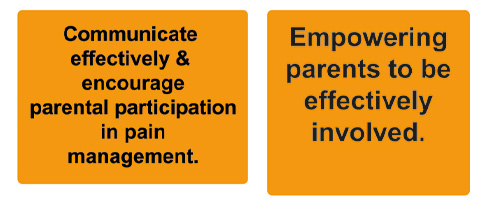4 Empowering parents
The fourth section of the framework focuses on empowering parents to be effectively involved in the management of their child’s pain by encouraging their participation.
Earlier we learned that parents want to be involved in helping to alleviate their child’s pain, but are not sure how to go about it. Twenty years ago parents who were asked if they were involved in their child’s pain care said they heard what was discussed about their child’s pain management, suggesting that their involvement was passive (Simons et al 2001). However, more recently it was reported that when parents’ expectations were raised, pain management practice on the part of nurses improved (Simons 2015).
Activity 3: Parents expectations
How would you explain this finding?
How do you think the raising of parents expectations had a positive impact on nurses pain management practice?
Make a note of what you think the explanation could be.
Answer
This finding came from interviews with health care practitioners in Sweden who found that when parents became more confident in approaching the nurses when their child was experiencing pain, nurses responded by being more responsive to parents and this change in practice improved the management of children’s pain.
The pain leaflet you have just looked at attempts to facilitate parents feeling more confident to approach nurses when their child is experiencing pain.
Sharing information with parents as well as valuing their knowledge of their child and communicating in an equal partnership can establish parents’ and nurses’ expectations of parent involvement in the management of their child’s pain.
A lack of communication, information provision and poor negotiation of roles can result in missed opportunities for nurses to work in partnership with parents (Vasey et al 2019).
Sometimes information provision can be inconsistent, resulting in parents having sufficient information about some aspects (e.g., the surgical procedure) but not others (e.g., pain medication) (Gai et al 2020). Although some participants were cautious about raising parents’ expectations, most talked of this as a key element to effective pain management. The skill lies in how practitioners engage and communicate with parents and the information they share with them.
One obstacle for some parents in approaching a nurse is the belief that the nurse is too busy already, or that they know their child is in pain and there is nothing that can be done about it. Also, parents may not know how to ask for more pain relief, and may need some support and guidance, even encouragement, to do so.
Preparation and information giving to parents were identified as key components. As with other studies (Zhu et al 2018), we identified the need for better communication and information to enable parents to effectively participate in managing their child’s post-operative pain.
Where parents (and children) are given information on pain management, studies have shown that this results in satisfaction with care (Twycross and Finley 2013) and parents have been found to be satisfied with their child’s care, even when they report that their child experienced pain. (Twycross and Finley 2013). This seeming contradiction has been explained by parents having low expectations of their child’s pain being managed well, and therefore reporting that they were satisfied with the care, even though their child had pain.
Clearly, empowerment can only really be achieved with consistent and high-quality information that supports parents’ expectations of good care and gives them the confidence to complain about poor pain management (Twycross 2013: Sutters et al 2007). Paradoxically, research has found that strategies to improve pain management and encouraging greater engagement from parents can result in more complaints from parents (Simons 2015); this may be the outcome of parents being more informed, confident and having higher expectations of what can be achieved.
Empowering parents makes considerable sense, as they are their child’s most consistent caregivers, and therefore an obvious source of personalized knowledge to assist in identifying and implementing strategies to optimize better pain care (Bettle et al 2018). However, it is important to recognise when a parent or carer can’t or wont advocate on the part of a child. The onus then is on the nurse to proactively evaluate that child’s pain regularly.

